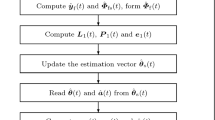Abstract
Autoregressive (AR) models play a role of paramount importance in the description of scalar and multivariate time series and find many applications in prediction and filtering. The main limit of AR models is associated with their elementary description of the misfit between observations and model (equation error considered as a white noise). A more realistic family of autoregressive models is given by “AR+noise” ones where besides a white equation error also additive white noise on the observations is considered. Noisy AR models have given very good results in practical applications and lead to more realistic descriptions of the underlying processes; for these reasons, they are intrinsically more suitable than AR models for filtering applications. The use of AR+noise models in filtering requires the construction of a state-space realization and Kalman filtering. This article proposes an efficient innovation-based filtering approach whose computational burden is lower than that of Kalman filtering. The proposed algorithm relies directly on polynomial input–output models and on Cholesky factorization.
Similar content being viewed by others
References
Kay S.M.: Modern Spectral Estimation. Prentice-Hall, Englewood Cliffs (1988)
Haykin S.: Adaptive Filter Theory. Prentice-Hall, Englewood Cliffs (1991)
Haykin, S., Steinhardt, A. (eds): Adaptive Radar Detection and Estimation. Wiley, Amsterdam (1992)
Takalo R., Hytti H., Ihalainen H.: Tutorial on univariate autoregressive analysis. J. Clin. Monit. Comput. 19, 401–410 (2005)
Hytti H., Takalo R., Ihalainen H.: Tutorial on multivariate autoregressive modelling. J. Clin. Monit. Comput. 20, 101–108 (2006)
Kay S.M.: Noise compensation for autoregressive spectral estimates. in: IEEE Trans. Acoust. Speech Signal Process. 28, 292–303 (1980)
Sen Lee T.: Large sample identification and spectral estimation of noisy multivariate autoregressive processes. in: IEEE Trans. Acoust. Speech Signal Process. 31, 76–82 (1983)
Davila C.E.: A subspace approach to estimation of autoregressive parameters from noisy measurements. in: IEEE Trans. Signal Process. 46, 531–534 (1998)
Zheng W.X.: A least-squares based method for autoregressive signals in the presence of noise. in: IEEE Trans. Circuits Syst. II 46, 81–85 (1999)
Grivel E., Gabrea M., Najim M.: Speech enhancement as a realisation issue. Signal Process. 82, 1963–1978 (2002)
Hasan Md.K., Hossain Md.J., Haque Md.A.: Parameter estimation of multichannel autoregressive processes in noise. Signal Process. 83, 603–610 (2003)
Zheng W.X.: Fast identification of autoregressive signals from noisy observations. in: IEEE Trans. Circuits Syst. II 52, 43–48 (2005)
Bobillet W., Diversi R., Grivel E., Guidorzi R., Najim M., Soverini U.: Speech enhancement combining optimal smoothing and errors-in-variables identification of noisy AR processes. in: IEEE Trans. Signal Process. 55, 5564–5578 (2007)
Diversi R., Guidorzi R., Soverini U.: Identification of autoregressive models in the presence of additive noise. Int. J. Adapt. Control Signal Process. 22, 465–481 (2008)
Oppenheim A.V., Weinstein E., Zangi K.C., Feder M., Gauger D.: Single-sensor active noise cancellation. in: IEEE Trans. Speech Audio Process. 2, 285–290 (1994)
Gannot S., Burchtein D., Weinstein E.: Iterative and sequential Kalman filter-based speech enhancement algorithms. in: IEEE Trans. Speech Audio Process. 6, 373–385 (1998)
Gevers M.R.: ARMA models, their Kronecker indices and their McMillan degree. Int. J. Control 43, 1745–1761 (1986)
Guidorzi R.P.: On the use of minimal parametrizations in multivariable ARMAX identification. Eur. J. Control 4, 85–92 (1998)
Anderson B.D.O., Moore J.B.: Optimal Filtering. Prentice-Hall, Englewood Cliffs (1979)
Rissanen J., Barbosa L.: Properties of infinite covariance matrices and stability of optimum predictors. Inf. Sci. 1, 221–236 (1969)
Caines P.E.: Linear Stochastic Systems. Wiley, New York (1988)
Golub G.H., Van Loan C.F.: Matrix Computations. Johns Hopkins University Press, Baltimore (1983)
Author information
Authors and Affiliations
Corresponding author
Rights and permissions
About this article
Cite this article
Diversi, R., Guidorzi, R. Optimal filtering of multivariate noisy AR processes. SIViP 7, 873–878 (2013). https://doi.org/10.1007/s11760-011-0276-y
Received:
Revised:
Accepted:
Published:
Issue Date:
DOI: https://doi.org/10.1007/s11760-011-0276-y




